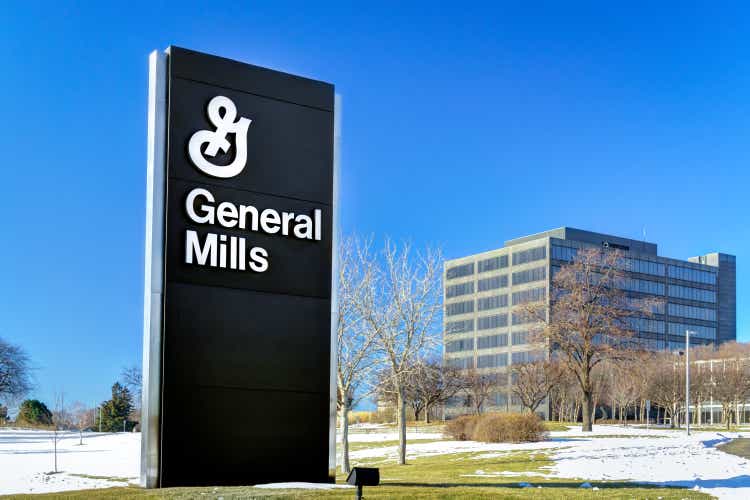Wolterk/iStock Editorial via Getty Images
Shares of General Mills (NYSE:GIS) held up quite well despite an inflationary environment in combination with rapidly raising rates. As my last take on the business dates back to the spring of 2020, amidst the outbreak of the pandemic, and General Mills announcing a small divestment, let’s see how the business has fared.
A Look Back
In March 2020, I concluded that General Mills was muddling through despite a short-term benefit provided by Covid-19 induced panic buying spree. Whilst anticipating a short-term boost to the results, I believed that organic growth might continue to be an issue despite the recent Blue Buffalo purchase.
General Mills is a $17 billion business, at least back in 2019, with most revenues generated in North America, complemented by smaller operations in Europe and Asia. The company is strong in cereal, yogurt, snack & meals, dough & baking mixes and what it calls accelerate segments. Besides these people food businesses, the company made a huge entrance into organic animal food as well, following a $8 billion purchase of Blue Buffalo.
Amidst the outbreak of the pandemic, the company posted third quarter results which revealed largely flattish year-over-year trends. The company was set to generate $3.6 billion in EBITDA on the $17 billion in sales, translating into decent margins, as leverage was elevated at 3.6 times given a net debt load of $13.0 billion following the Blue Buffalo deal. Adjusted earnings of $3.20 per share closely mimic realistic earnings, working down to a 15 times multiple at $48 per share, resulting in a reasonable earnings multiple, yet leverage was high and growth was not impressive.
Given that backdrop, the valuation looked quite fair in my eyes, as I did not see any reasons to get involved with the stock or company at the time.
A Look Forward
Fast forwarding since the pandemic days of March 2020, shares have rallied a cumulative 40% to $70 here, as shares have been trading in a relatively tight range between $60 and $75 per share in recent times. The company has been active in repositioning its portfolio in 2021. In March, the company announced the sale of its European Yoplait operations, selling a majority stake in this $740 million European business.
In May, General Mills announced a $1.2 billion deal to acquire Tyson’s (TSN) Pet Treats business, adding to its animal food platform, albeit that a premium with sales generated at just $240 million per annum, resulting in a 5 times sales multiple being paid, although this dropped to roughly 4 times after factoring in tax benefits. Towards the end of the year, the company reached a deal to sell its European dough business, albeit no financial details have been announced upon the deal announcement.
In March, the company posted third quarter results with organic growth posted in the low to medium single digits, with organic growth seen at 5%. This is better than it sounds as input inflation runs at high single digits, and with adjusted earnings seen largely flat this year, that reveals that most growth comes from pricing. With earnings reported at $3.07 per share in the first three quarters of the year, the company has made real strives as earnings per share have improved from about $3 per share to a run rate of around $4 per share. This is encouraging, certainly as net debt has been cut to $10.7 billion, quite comforting as EBITDA trends around $3.9 billion by now.
Since the release of the first quarter results, General Mills has executed two more deals, too small to move the needle. In May, General Mills sold the Helper and Suddenly Salad business in a $610 million deal which sheds some $235 million in sales and reduces earnings by ten to eleven cents. Around the same time, the company announced a purchase of TNT Crust to grow its presence in the home-away pizza business. While the purchase price has not been quantified, the deal was set to add $100 million in sales, as both these deals are relatively small.
And Now?
Between the early days of the pandemic and now, shares have risen 40%, mostly as a result of improved earnings power which has risen from $3 to $4 per share, as valuation multiples have expanded a bit as well, but at 17-18 times earnings, the multiple seems fair, albeit that interest rates move up quicker. Growth is found here, but in all reality, this is mostly inflation compensation, as leverage has been reduced to 2.8 times EBITDA, a very reasonable valuation multiple by all means.
Hence, General Mills still falls within a long-term defensive corner if you ask me, as the current valuation is fair at best with inflation helping in the near term, but likely having an impact on the long haul, all while higher interest rates have reduced the relative appeal, leaving me to conclude with a largely neutral stance here.


Be the first to comment